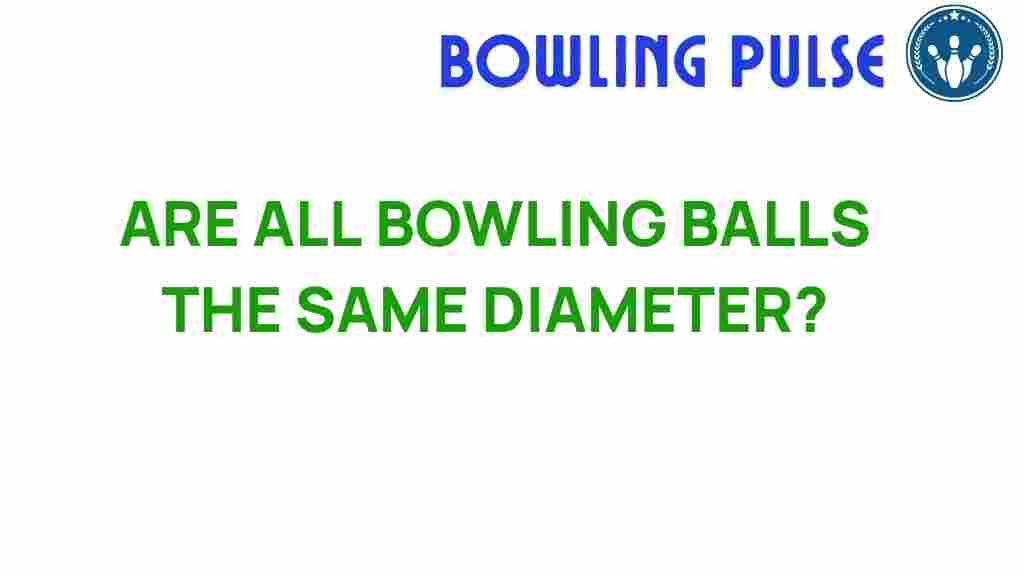Are All Bowling Balls the Same Diameter?
When it comes to understanding the intricacies of the bowling game, one of the common misconceptions is that all bowling balls are created equal, particularly regarding their diameter. This myth can lead to confusion, especially for newcomers to the sport. In this article, we will delve into the specifications of bowling balls, exploring their diameter and how it impacts your performance in the game. By unraveling these myths, we aim to provide clarity on bowling equipment and its specifications, enhancing your understanding of this beloved sport.
Understanding Bowling Ball Specifications
The diameter of a bowling ball is one of the fundamental specifications that every bowler should be aware of. In the bowling industry, standard bowling balls for adults are generally manufactured to a diameter of 8.5 inches (approximately 21.6 cm). However, there are variations based on the type of bowling ball, the intended use, and the bowler’s preferences.
Standard Bowling Ball Sizes
Bowling balls come in various sizes and weights, tailored to different age groups and skill levels. Here is a breakdown of the standard sizes:
- Adult Bowling Balls: Typically have a diameter of 8.5 inches.
- Youth Bowling Balls: These balls can be slightly smaller, ranging from 6 to 8 inches in diameter.
- Children’s Bowling Balls: Designed for younger players, often measuring around 6 to 7 inches in diameter.
- Specialty Balls: Some balls, such as those used for candlepin bowling, have different diameters and specifications.
Understanding these specifications is crucial for choosing the right equipment that suits your bowling techniques and style.
Impact of Diameter on Bowling Techniques
The diameter of a bowling ball directly influences how it behaves on the lane. Here are some points to consider about how diameter impacts bowling techniques:
- Grip and Control: A properly sized ball allows for better grip, enhancing control over your shots. An oversized ball can lead to poor delivery and accuracy.
- Spin and Hook: The ball’s diameter can affect how much spin or hook you can put on the ball. A ball that is too large may limit your ability to impart spin.
- Weight Distribution: Different diameters can affect the weight distribution of the ball, which in turn influences ball speed and trajectory.
As you refine your bowling techniques, understanding how diameter plays a role can lead to improved performance on the lanes.
Common Myths About Bowling Balls
Several myths exist regarding bowling balls and their specifications. Let’s debunk some of the most common ones:
Myth 1: All Bowling Balls Are the Same
As we’ve established, this is not true. Bowling balls come in various sizes and weights, catering to different players and styles. The diameter varies depending on the intended use and player preferences.
Myth 2: Heavier Balls Are Always Better
Many beginners believe that heavier bowling balls guarantee better performance. While a heavier ball can create more pin action, it’s essential to choose a weight that you can control. The diameter also plays a role in how the weight feels in your hand.
Myth 3: You Can’t Use a Lighter Ball
Some players think using a lighter ball will negatively impact their game. However, lighter balls can be more manageable, especially for beginners, and can still be effective for strikes and spares.
Choosing the Right Bowling Ball Diameter
Choosing the right diameter for your bowling ball is crucial for your performance. Here’s a step-by-step process to help you select the best option:
Step 1: Assess Your Skill Level
Beginners should start with a lighter ball that they can control easily. As you progress, you may want to experiment with different diameters and weights.
Step 2: Determine Your Grip
Try different balls to find one that feels comfortable in your hand. The grip should feel secure without straining your fingers or hand.
Step 3: Consult with Professionals
Visit a local pro shop and seek advice from experienced bowlers or professionals. They can guide you on the best bowling equipment suited for your style.
Step 4: Test Different Balls
Before making a purchase, test various bowling balls at your local bowling alley. This hands-on experience will give you a better feel for what works for you.
Troubleshooting Tips for Bowling Ball Diameter Issues
If you find that your bowling ball isn’t performing as expected, consider the following troubleshooting tips:
- Check Your Grip: If your grip feels uncomfortable or loose, the diameter may not be suitable. Consider adjusting to a different size.
- Assess Your Technique: Sometimes, issues stem from technique rather than equipment. Work on your form and approach.
- Seek Professional Advice: If you’re struggling, don’t hesitate to ask for help from bowling coaches or pro shop staff.
Finding the right bowling ball diameter can significantly enhance your overall experience and performance in the game.
Conclusion
In summary, the diameter of bowling balls is not uniform across the board. Understanding the variations in diameter and how they impact your bowling techniques is essential for improving your game. By debunking common myths and choosing the right bowling equipment, you can maximize your performance on the lanes.
Whether you are a beginner or an experienced bowler, being informed about ball specifications can make a substantial difference. Always remember that the right diameter can enhance your grip, control, and overall enjoyment of the bowling game.
For more information about bowling techniques and equipment, check out this comprehensive guide. Additionally, to stay updated on the latest in the bowling industry, visit Bowling.com.
This article is in the category Equipment and created by BowlingPulse Team

2 thoughts on “Are All Bowling Balls the Same Diameter? Unraveling the Myths”